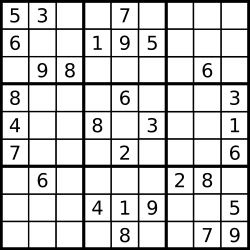Write a program to solve a Sudoku puzzle by filling the empty cells.
Empty cells are indicated by the character
'.'.You may assume that there will be only one unique solution.

A sudoku puzzle...

...and its solution numbers marked in red.
------------------------------------------set up three 2D arrays as caches to store used numbers in each row, column and sub-block
class Solution {
public:
bool sudoku (vector<vector<char> > &board, vector<vector<bool> > &rows,
vector<vector<bool> > &cols, vector<vector<bool> > &subs, int index) {
if (index == 81) {
return true;
}
int rowIndex = index / 9;
int colIndex = index % 9;
if (board[rowIndex][colIndex] == '.') {
for (int i = 0; i < 9; i++) {
if (!(rows[rowIndex][i] || cols[colIndex][i] || subs[(rowIndex / 3) * 3 + colIndex / 3][i])) {
board[rowIndex][colIndex] = '1' + i;
rows[rowIndex][i] = true;
cols[colIndex][i] = true;
subs[rowIndex / 3 * 3 + colIndex / 3][i] = true;
// if conditions is false, backtrack
if (!sudoku(board, rows, cols, subs,index + 1)) {
board[rowIndex][colIndex] = '.';
rows[rowIndex][i] = false;
cols[colIndex][i] = false;
subs[rowIndex / 3 * 3 + colIndex / 3][i] = false;
}else {
return true;
}
}
}
return false;
}else {
// if slot is filled already
return sudoku(board, rows, cols, subs,index + 1);
}
}
void solveSudoku(vector<vector<char> > &board) {
// declare and populate caches
vector<vector<bool> > rows(9,vector<bool>(9,false));
vector<vector<bool> > cols(9,vector<bool>(9,false));
vector<vector<bool> > subs(9,vector<bool>(9,false));
for (int rowIndex = 0; rowIndex < 9; rowIndex++) {
for (int colIndex = 0; colIndex < 9; colIndex++) {
if (board[rowIndex][colIndex] != '.') {
int val = board[rowIndex][colIndex] - '1';
rows[rowIndex][val] = true;
cols[colIndex][val] = true;
subs[(rowIndex / 3) * 3 + colIndex / 3][val] = true;
}
}
}
// recursive call starts here
sudoku(board,rows,cols,subs,0);
}
};
Combination Sum IIGiven a collection of candidate numbers (C) and a target number (T), find all unique combinations in C where the candidate numbers sums to T.
Each number in C may only be used once in the combination.
Note:
- All numbers (including target) will be positive integers.
- Elements in a combination (a1, a2, … , ak) must be in non-descending order. (ie, a1 ≤ a2 ≤ … ≤ ak).
- The solution set must not contain duplicate combinations.
10,1,2,7,6,1,5 and target 8, A solution set is:
[1, 7] [1, 2, 5] [2, 6] [1, 1, 6]------------------------------------------------------------
Similar to #39 Combination Sum
class Solution {
public:
void comb (vector<int>& candidates, int target, vector<vector<int> > &ret, vector<int> cur,int start) {
if (target == 0) {
ret.push_back(cur);
}else {
for (int i = start; i < candidates.size(); i++) {
if (target - candidates[i] >= 0) {
vector<int> v= cur;
v.push_back(candidates[i]);
comb(candidates,target-candidates[i],ret,v,i+1); // no element can be re-used, so i + 1
}
// skip duplicates
while (candidates.size() - 1 > i && candidates[i] == candidates[i + 1]) {
i++;
}
}
}
}
vector<vector<int> > combinationSum2(vector<int> &num, int target) {
sort(num.begin(),num.end());
vector<vector<int> > ret;
vector<int> cur;
comb(num,target,ret,cur,0);
return ret;
}
};
类似
class Solution {
public:
void helper(vector<vector<int>> &rt,vector<int>& candidates, vector<int> cur,int target,int index) {
if (target == 0) {
rt.push_back(cur);
return;
}
if (target < 0 || index >= candidates.size()) return;
vector<int> temp = cur;
temp.push_back(candidates[index]);
helper(rt,candidates,temp,target - candidates[index],index + 1);
while (index + 1 < candidates.size() && candidates[index] == candidates[index + 1]) {
index++;
}
helper(rt,candidates,cur,target,index + 1);
}
vector<vector<int>> combinationSum2(vector<int>& candidates, int target) {
sort(candidates.begin(),candidates.end());
vector<vector<int>> rt;
vector<int> cur;
helper(rt,candidates,cur,target,0);
return rt;
}
};
No comments:
Post a Comment